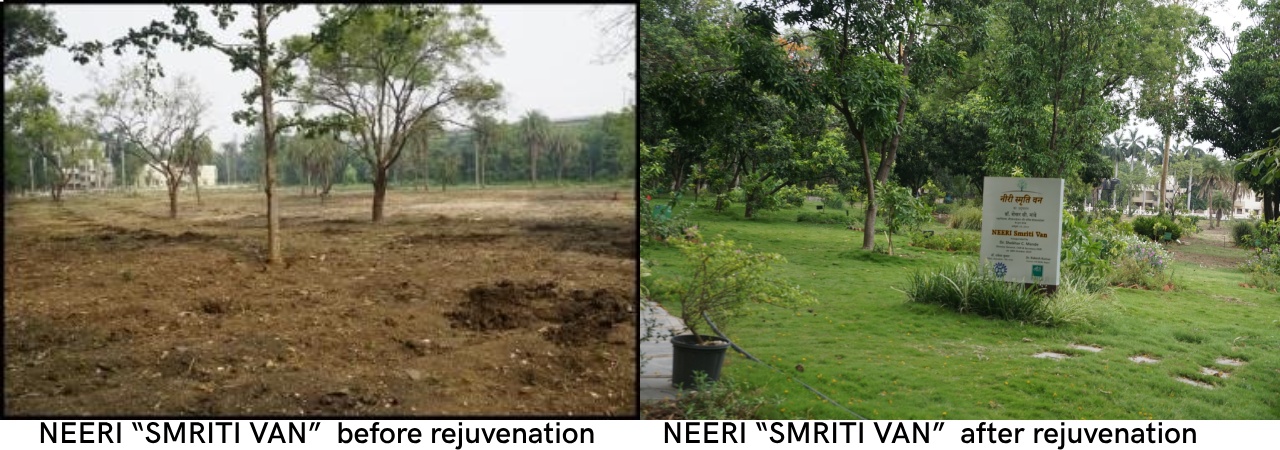
A constituent laboratory of Council of Scientific & Industrial Research (CSIR)
(AUTONOMOUS ORGANISATION UNDER THE DEPT. OF SCIENTIFIC & INDUSTRIAL RESEARCH, MINISTRY OF SCIENCE & TECHNOLOGY, GOVT. OF INDIA)


“Smriti Van” is an urban institutional native ecosystem park spread in seven acre area developed in CSIR-NEERI, Nagpur. It is a prototype developed for native biodiversity management spaces in industrial or educational firms. It is a sustainable organic garden that supports the growth of only the native plant species and does not include any exotic or invasive species. NEERI SMRITI VAN consists of more than 250 types of plants of 42 families. Which are growing in a proper condition and some tree species are grown naturally.The tree species selected include Mangifera indica (mango), Syzygium cumini (Jamun/Java plum), Saraca asoca (Ashoka), Citrus aurantifolia (lime), Azardiracta indica (neem), Peltophorum pterocarpum(copper pod), Bauhinia variegate kachnar, Albizia procera (white siris), Mimusops elengi(molseri), Terminalia catappa(Deshi badam) Phoenix sylvestris (date palm), Manilkara zapota (chiku) etc., All of which are native to the region (Central India). The garden also includes native traditional medicinal plants like Zingiber officinale, Curcuma longa, Tagetes erecta, Piper longum, Andrographis paniculata, Colius aromaticus, Kaempferia galanga, Costus speciosus, Withania somnifera, Gymnema sylvestre, Ocimum gratissimum, Mentha spicata, Adhatoda zeylanica, Asparagus racemosus, Aloe vera, Ocimum basilicum, Vitish quadrangularis, Cyperus compresus, Bacopa monnieri, Centella asiatica, Cinnamomun tamala, Acorus calamus, Cesalpinia bonduc, Murraya koenigi, Costus spicatus, Barlaria cristata, Bixa orellana, Accacia concinna, Lawsonia inermis, Barlaria priontis, Cissus rotundifolia, Justica spicigera, Clitoria terneta, Phyllanthus acidus, Alchornea laxiflora, Mimosa pudinca, Kalanchoe beharensis, Bryophyllum pinnatum, Stevia rebaudiana, Eleocarpus ganitrus, Alpinia galangal, Chrysopogon zizanioides, Cymbopogon citrates, Abelmoschus moschatus, Ficus lyrata, Gardenia gummifera, Ficus carica, Meusa ferra, Tylophora indica, Vitex negundo, Ficus krishnae, Catharanthus roseus, Catharanthus alba, Clerodendron infortunatum, Simarouba glauca, Neolamarckia cadamba, Sapindus mukorossi, Persea americana, Haldina cordifolia, Pterocarpus santalinus, Couroupita guianensis, Abroma augusta, Acmella olreracea, Calotropis procera, Lagerstroemia speciosa, Grewia asiatica, Carissa carandas, Carissa carandas, Rauvolfia serpentine, Premna serrtifolia, Myristica fragrans, Syzygium aromaticum, Hygrophila auriculata, etc. which add to cultural, health and social significance. So basically, the constructed landscape includes a recreational orchard and a medicinal herbal garden for the students, visitors, stakeholders, and dignitaries. The site selected was within CSIR-NEERI institutional premises. It was not a polluted land, but unused open space. The creation of native floral biodiversity can attract and serve as a potential habitat for native fauna Some important birds as Ocyceros birostris, Columba livia domestica, Psittaciformes, Amazona viridigenalis, Pycnonotus cafer, Pavo cristatus, Dinopium benghalense, Acridotheres tristis, Vanellus indicus. Butterfly as Nymphalidae, Pieridae, Hesperiidae, eastern grass gel, Colotis amata, Catopsilia pomona, Delias eucharis, Danaus chrysippus, Junonia orithiya, Pareronia valeria and various species of insects, betel etc.
Natural green spaces significantly enhance the quality of the urban environment and life in Major cities. The distribution of rare, threatened and medicinally important biodiversity on the eco-parks in a city should be optimal for social integration among the residents. Eco-parks should be planned and maintained in such a way that a balance exists between extraction of resources and conservation of species diversity, or else there may be public conflicts. The development of a managed naturalized ecosystem, as well as landscape of aesthetic value, can deliver cultural and educational benefits to the public. NEERI’s Smriti Van can be a prototype for sustainable botaniculture and eco-rejuvenation approaches to combat habitat loss and protect local flora and fauna, by revamping the fragmented natural landscape.